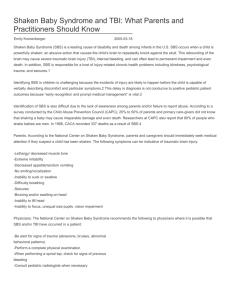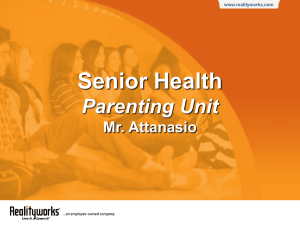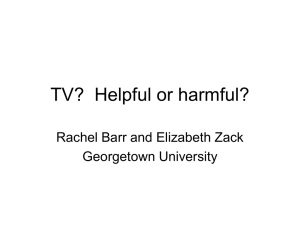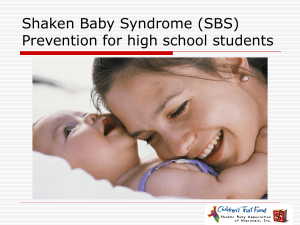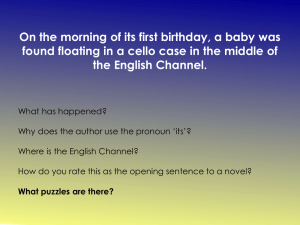File - Shaken Baby Syndrome
advertisement
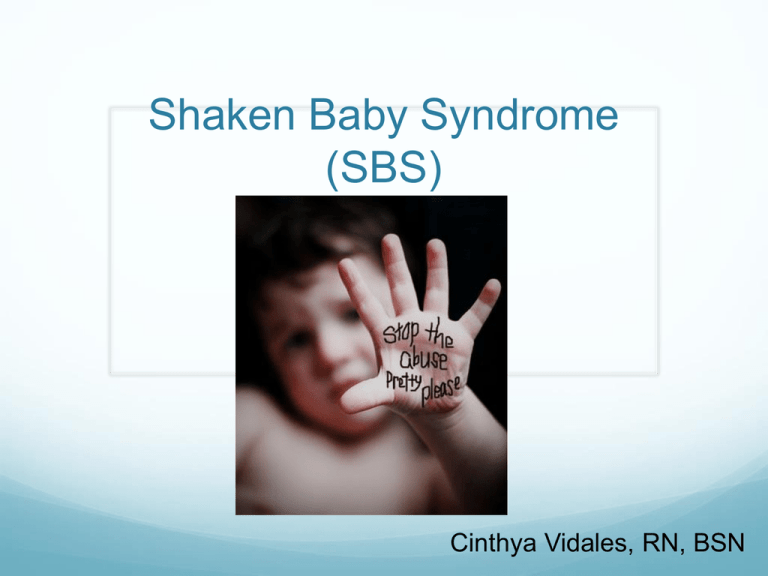
Shaken Baby Syndrome (SBS) Cinthya Vidales, RN, BSN What is Shaken Baby Syndrome (SBS)? Another name is Abusive Head Trauma (AHT) or Shaken Impact Syndrome (SIS). This happens when a “frustrated caregiver violently shakes, slams, hits, or punches a child’s head, usually to stop them from crying or to get them to respond to the expectations of the caregiver” (The Shaken Baby Alliance, 2009). What is Shaken Baby Syndrome (SBS)? The baby’s brain rebounds inside the skull when shaken. This injury will cause bruising of the brain, swelling, pressure, and bleeding (intracerebral hemorrhage). This can easily lead to permanent brain damage or death (Kaneshiro & Zieve, 2011). Statistics SBS is a leading cause of child abuse deaths in the United States. At least one in four babies dies as a consequence of this form of abuse. Infants up to 4 months are at greatest risk of injury from shaking Inconsolable crying is a primary trigger for shaking a baby. CDC, 2010 Statistics It is estimated that approximately 1,000 to 3,000 children suffer from SBS 80 percent of survivors suffer from permanent damage. the United States, the costs of hospitalization and continuing care for SBS victims can total $1.2 to $16 billion dollars each year. (New York State Dept of Health, 2010) Statistics It is estimated that perpetrators in 65% to 90% of cases are males — usually either the baby's father or the mother's boyfriend, often someone in his early twenties (KidsHealth, 2012). Can occur in as little as 5 seconds of shaking (Kaneshiro & Zieve, 2011). Videos on SBS http://www.youtube.com/watch?v=6tEm2u-Epr0 http://www.youtube.com/watch?v=M3xytsg6oDo&feature= related What happens when shaking a baby 3D Simulation of brain injury and hemorrhage http://www.youtube.com/watch? v=l_toKPs9Jj4&feature=fvwrel http://www.youtube.com/watch?v=DkRZ0y2vEHY Remember: Shaken Baby Syndrome is a Preventable Public Health Problem! CDC, 2010 What are the signs? Usually there are no outward physical signs of trauma, but there may be a change in the child's behavior such as irritability, lethargy, pale or bluish skin, vomiting, and convulsions (Kaneshiro & Zieve). Signs May also exhibit limpness in arms and legs or rigidity/posturing Decreased level of consciousness Vomiting; poor feeding Inability to suck or swallow Changes in feeding and napping patterns Clinical Manifestations Respiratory difficulty including apnea Decreased level of consciousness Seizure activity Bradycardia Bulging fontanels indicative of increased intracranial pressure Possible complete cardiovascular collapse requiring CPR (Miehl, 2005) Diagnostic Exams CT scan MRI scan Eye examination Clinical Findings Subdural hemorrhage (A) Retinal detachment/hemorrhage (B) B A Retinal Hemorrhage Retinal hemorrhage is a cardinal display of Shaken Baby Syndrome. Occurs from the repeated acceleration-deceleration forces Results in vitreo-retinal traction and perhaps damage to blood vessels and nerves behind the eye (orbit) Essential that ophthalmologists familiar with ocular findings in SBS, evaluate suspected child victims (Levin, 2006) Subdural Hemorrhage The brain rotates within the skull cavity, injuring, or destroying brain tissue When shaking occurs, blood vessels feeding the brain can be torn, leading to bleeding around the brain. Blood pools within the skull, sometimes creating more pressure within the skull and possibly causing additional brain damage. The National Center on Shaken Baby Syndrome, (n.d) Long-Term Consequences : Learning & Physical disabilities Visual disabilities or blindness SBS survivors may have long term visual compromise. The main cause is brain injury to the vision centers (occipital lobes) and direct optic nerve injury. Hearing impairment Cognitive impairment Speech disabilities Cerebral Palsy Seizures Behavior disorders Death The National Center on Shaken Baby Syndrome, (n.d) Tips for Parents It is important to educate parents and caregivers about the dangers of SBS. Anyone caring for a child should know that if a baby is not uncomfortable or sick but will not stop crying, it is okay to put the baby down in a safe place (like a crib) and take a short break to relax. • New parents should know that it is common for babies to cry for up to three hours a day – some cry even more than this. •Some states such as New York have legislation requiring that hospital maternity wards offer to show new parents a video on shaken baby syndrome before they leave the hospital. • If you suspect a baby has been shaken, you should call 911 or take the baby to the closest hospital emergency room. (New York State Dept of Health, 2010) Tips for Parents NEVER shake a baby or child in play or in anger. Even gentle shaking can become violent shaking when you are angry. Do not hold your baby during an argument. If you find yourself becoming annoyed or angry with your baby, put him in the crib and leave the room. Try to calm down. Call someone for support. Call a friend or relative to come and stay with the child if you feel out of control. Contact a local crisis hotline or child abuse hotline for help and guidance. Seek the help of a counselor and attend parenting classes. Do not ignore the signs if you suspect child abuse in your home or in the home of someone you know. Kaneshiro & Zieve, 2011 NEVER NEVER NEVER SHAKE A BABY!!! Further Study Click on the following link to read more on SBS http://www.dontshake.org/sbs.php?topNavID=3&subNavI D=23 Quiz Please follow the link on the website to take the quiz on Shaken Baby Syndrome. At the end of the quiz you will be able to see the correct answers. References Centers for Disease Control and Prevention, National Center for Injury Prevention and Control. (2010). Heads Up: Preventing Shaken Baby Syndrome- Guide for Departments and Community Based Organization. Retrieved January Health 31, 2012 from http://www.cdc.gov/Concussion/pdf/Preventing_SBS_508-a.pdf Kaneshiro, N. K & Zieve, D. (2011). Shaken Baby Symptoms. Retrieved January 30, 2012 from http://www.nlm.nih.gov/medlineplus/ency/imagepages/9013.htm KidsHealth (2012). Abusive Head Trauma (Shaken Baby Syndrome). Retrieved February 6, 2012 from http://kidshealth.org/parent/medical/brain/shaken.htm Levin, A. (2006). Eye Findings in Shaken Baby Syndrome. Retrieved January 31, 2012 from http://www.dontshake.org/sbs.php? topNavID=3&subNavID=25&navID=279 References: Miehl, N. (2005). Shaken Baby Syndrome: Clinical Presentation of SBS. Medscape. Retrieved January 31, 2012 from http://www.medscape.com/viewarticle/515880_4 New York State Department of Health (2010, October). Shaken Baby Syndrome: Facts and Figures. Retrieved February 3, 2012 from http://www.health.ny.gov/prevention/injury_prevention/shaken_baby_syndrome/ sbs_fact_sheet.pdf The National Center on Shaken Baby Syndrome (n.d). “Long-Term Consequences”. Retrieved January 31, 2012 from http://www.dontshake.org/sbs.php? topNavID=3&subNavID=23 The Shaken Baby Alliance. (2009). What is Shaken Baby Syndrome/Abusive Head Trauma? Retrieved January 30, 2012 from http://www.shakenbaby.com/WhatisSBSAHT/tabid/68/Default.aspx Videos Missouri Department of Health and Senior Services. (2011 Oct 10). Never Shake: Preventing Shaken Baby Syndrome. [Video file]. Retreived February 9, 2012 from http://www.youtube.com/watch? v=M3xytsg6oDo&feature=related New Mexico Aging and Long-Term Services Department. (2010 Nov 10). TBI in Young Children 4: Baby Syndrome and Normal Infant Crying. [Video file]. Retrieved February 3, 2012 from http://www.youtube.com/watch?v=6tEm2u-Epr0 Oopshansoo. (2010 Mar 17). Shaken Baby Syndrome 3D. [Video file]. Retrieved February 3, 2012 from http://www.youtube.com/watch?v=l_toKPs9Jj4&feature=fvwrel Tavares, S. (2008). The Rupture of Bridging Veins in Shaken Baby Syndrome. [Video file]. Retrieved February 3, 2012 from http://www.youtube.com/watch?v=DkRZ0y2vEHY Shaken
